Finding My Own Value: Double Mastectomy to Flat Closure with Decorative Tattoos
October 02, 2024
Content created for the Bezzy community and sponsored by our partners. Learn More
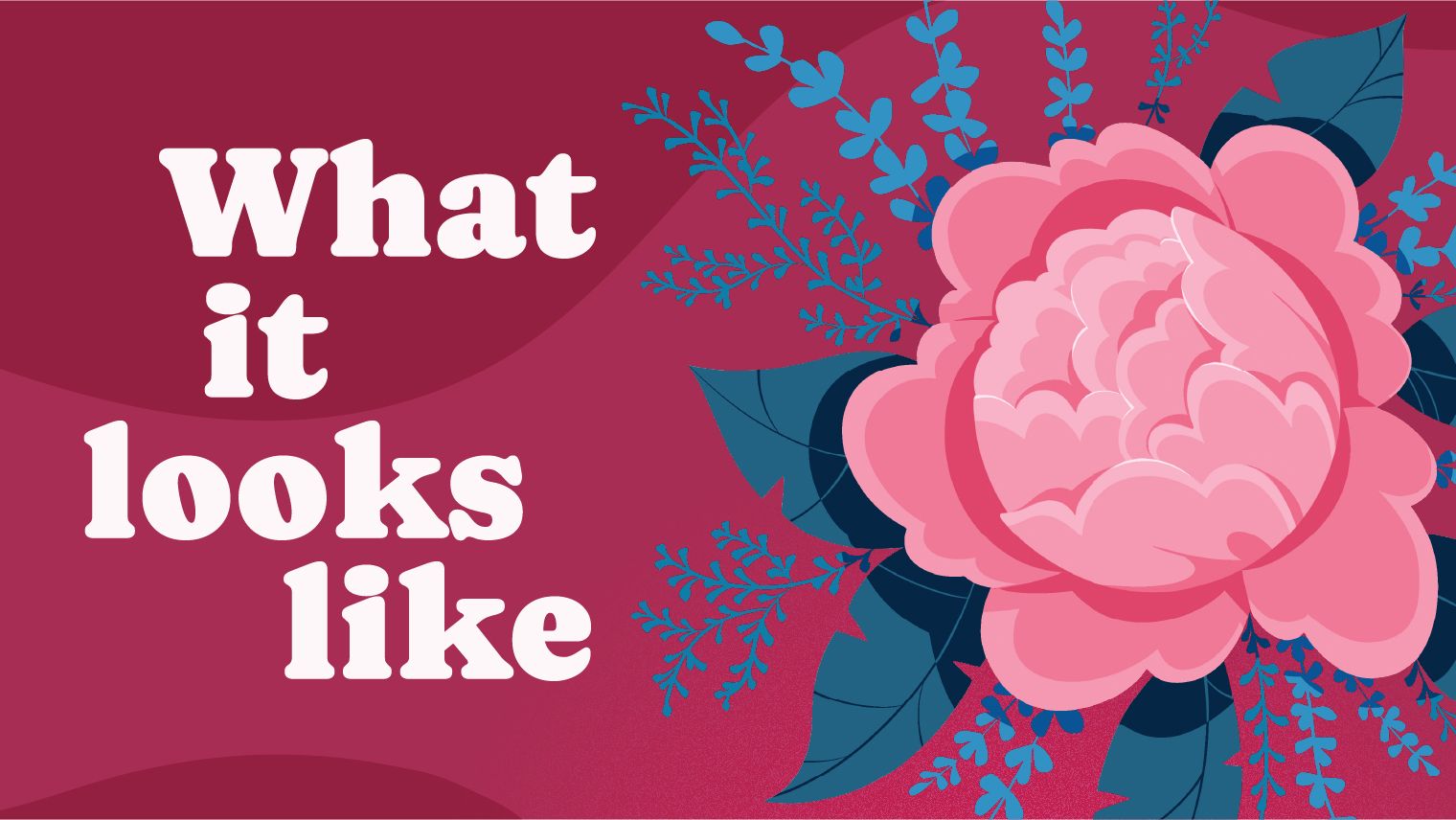
Illustration by Brittany England
My whole body knew that going flat was the path for me. Now I get to decide my worth and my value.
- Procedures: double mastectomy with flat closure
- Reconstruction immediately postmastectomy: no
- Year of procedure: 2022
- Age: 32 years old
This article contains graphic, intimate images of a postsurgery body. The photos have been generously shared by a breast cancer survivor so that others can benefit from uncensored visual information that may help them make important surgical decisions for themselves.


Diagnosis to surgery timeline
I was diagnosed with stage II invasive ductal carcinoma (IDC) in 2022 at 32 years old. I found a lump on Mother’s Day in my right breast during a self-exam. I called my gynecologist the next day.
I had just gotten back from Italy and had to recover from COVID-19 as well as an Achilles surgery from an injury. The earliest we could do a mammogram was June 20, and I was officially diagnosed on July 11.
My gynecologist had previously told me I had fibrous breasts. She told me to call her if I found a rock and lumpy mashed potatoes, so that’s what I was looking for. I found that description so helpful. I share it with everyone.
Once I found the lump, my husband intuited it was cancer right away. The medical staff were surprised. They kept saying, “You’re so young.”
Then, when it came time to make a decision, they asked you whether I’d like a lumpectomy or a mastectomy — like it’s “chicken or fish?”
My gut was telling me I didn’t want to do reconstruction then or ever, so I did some research so my head could catch up with what my gut knew.
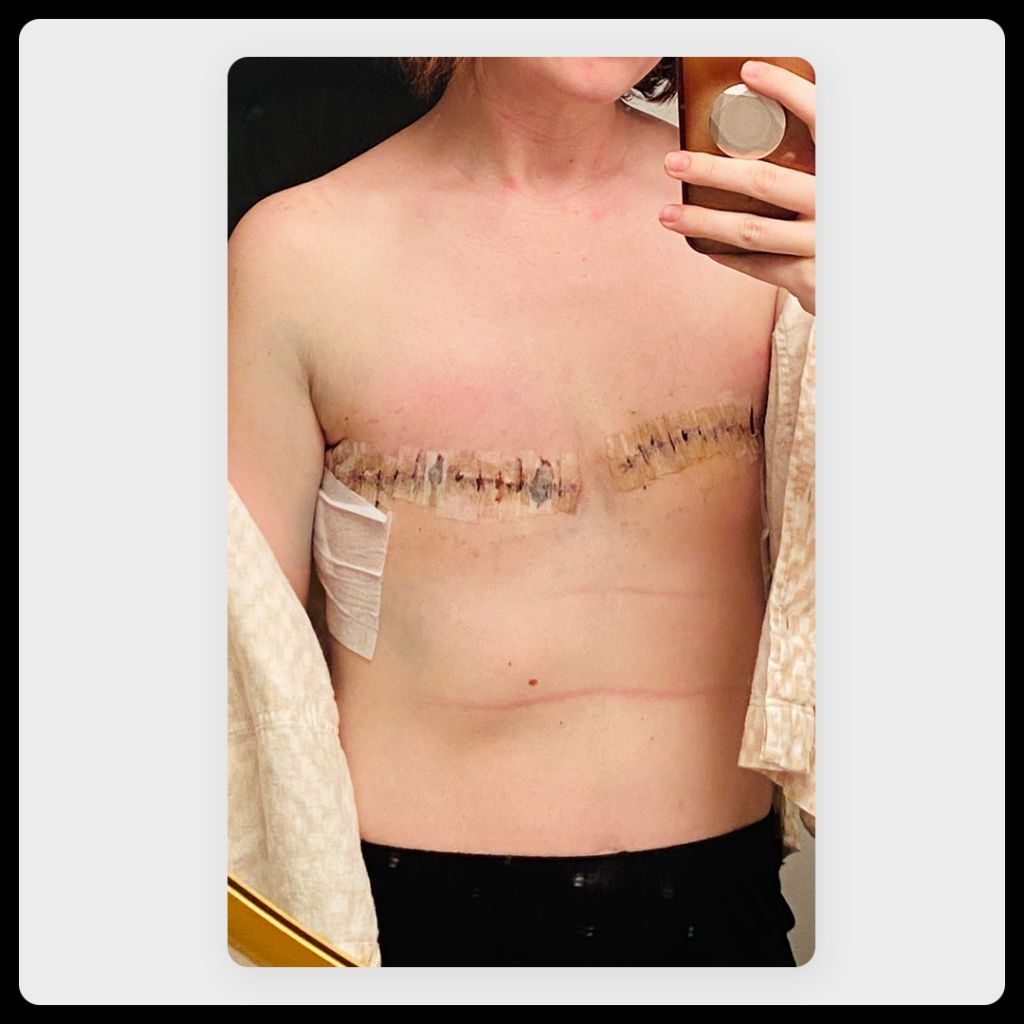
The surgery and recovery process
On August 1, I had a double mastectomy.
They give you a shot to inject blue dye into the breast tissue that intermingles with the lymph system so they can safely take the lymph nodes out during surgery.
I turned away as they put the needle in and thought, “This is the last time I’m ever going to feel pain in my breasts.” It was strangely comforting.
Right as they started wheeling me to surgery, I pretty much had a meltdown. I started crying and saying, “No, no.” Then they gave me something strong in my IV, and I was really happy all of a sudden.
The surgery took 3 hours. I woke up nauseated from the anesthesia and threw up six times. I didn’t learn until later that you can ask for a patch that’s placed behind the ear to prevent nausea before surgery.
I felt like my chest had just been slit open. I could only put weight on my left leg because of my Achilles surgery, and I couldn’t lift my arms. The nurse had to help scooch me off of the bed to pee in a bedside commode.
Then something strange happened when the surgeon came to visit me the next day. My body seized up in a panic. I had heart palpitations, I could barely talk, and I was shaking.
When I told my sister, she said, “Your brain was asleep, but your body wasn’t.”
Still, he was a great surgeon. I confirmed with him right before surgery that I wanted flat aesthetic closure because I’d heard a lot of doctors won’t do it. They’ll leave flaps because they think you can’t possibly want to be flat.
When it was time to go home, my family lifted my wheelchair over the couple of steps it took to get into our home. My sister and mother-in-law took great care of me and helped me empty the drains.
Those things suck. They’re the worst part of the whole thing. Luckily, I was able to get them out after only 5 days because there was so little fluid.
When I got them out, I yelled expletives in front of my mother-in-law because it was so painful. They’re spiraled in there under your chest, and they feel awful. Everything really hurts. Luckily, we had a good laugh about it.
Immediately after I got my drains out, one of my good friends came over, and I was able to help her cook dinner. I felt like a new person. Then, a day or 2 later, I had my first shower, and it was a life changing experience.
Before that, my husband brushed my teeth for me. My niece, who worked at an elderly care home, came over and sponge-bathed me. A lot of great people took care of me.
Once I recovered, I started focusing on physical therapy for my leg. I started hormone therapy 6 weeks after surgery, and I went back to work as a self-employed portrait photographer after 8 weeks.
I also tried the Zoladex shot once, but the side effects were so terrible that I decided not to do it. I thought, “I’ll probably get divorced and lose my business if I keep at this.” I had extreme mood swings and irritability — like the worst PMS you’ve ever had times 10. I was tired and achy, and my memory was terrible.
More like this
- I Advocated for Myself: Nipple-Sparing Double Mastectomy with Implant Reconstruction
- These Boobs Are All Me: Double Mastectomy and DIEP-Flap without Nipple
- Finally Happy: Double Mastectomy and Implant Reconstruction with Nipple Tattoo
- Hindsight Is 20/20: Double Mastectomy and DIEP Flap Reconstruction without Nipple
What cancer taught me
Facing my mortality was pretty earth-shattering. I wrote a list in my journal the night before my follow-up appointment titled, “Things I’ll do if I find out I have cancer tomorrow.”
Then I realized I’d better do this stuff whether I have cancer or not.
My list included making a movie and writing a book. I’ve already started the book.
I’m a recovering people-pleaser and used to do everything for external validation. I’d try to make everyone happy. I had already been on the path to change all that, but cancer threw that into hyperdrive. It taught me that at the end of the day, I have to be the one who has my back.
For instance, I was a glamor photographer and built my whole business and brand around that. But I’d been wanting to shift to raw, authentic portrait photography, so I went for it.
My life before cancer is kind of blurry, and now it’s all crystal clear. I didn’t survive cancer not to take this really cool but scary opportunity, or not tell this person what they mean to me, or not to jump in puddles with my toddler.
Cancer also taught me how to accept help. I think accepting help and accepting love is the same thing. That was always hard as a type A person.
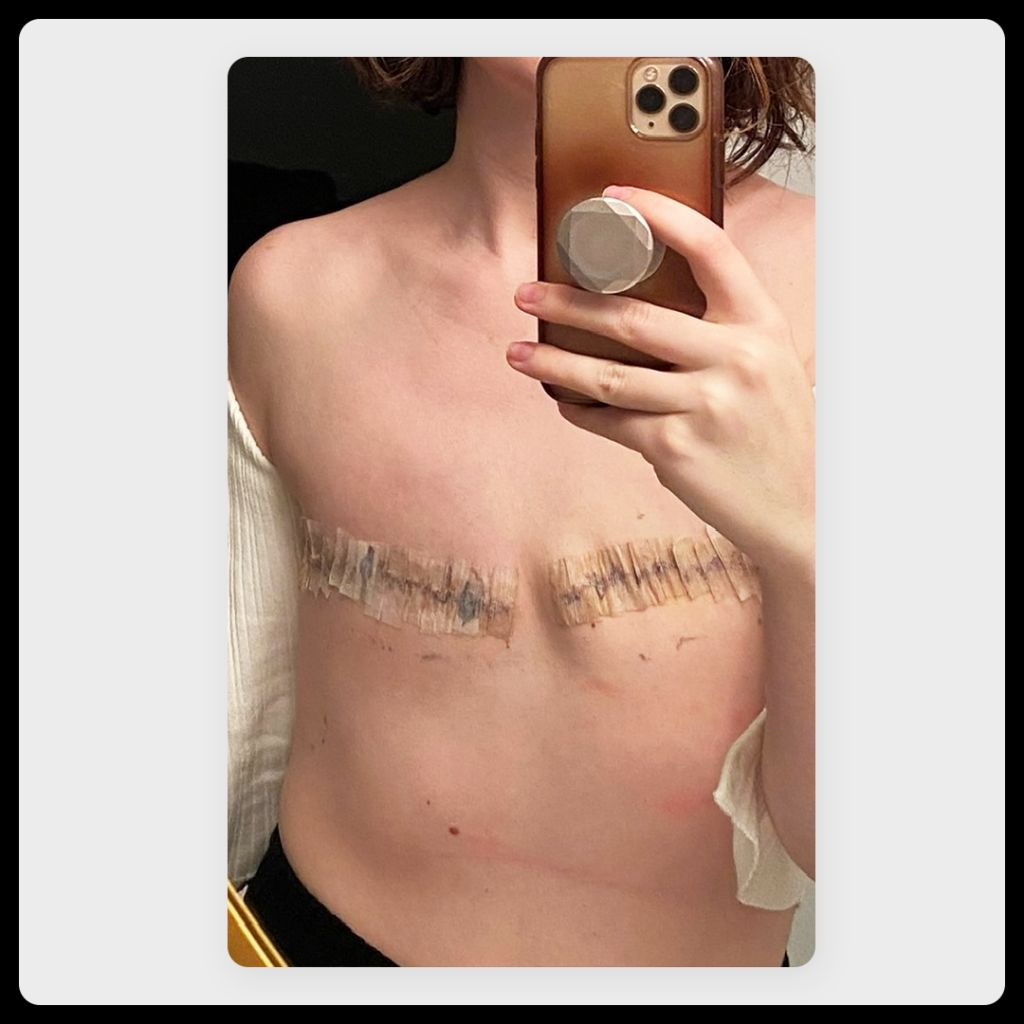
My decision to go flat
I actually have a lot of photography clients who are breast cancer survivors, so I reached out to them to ask them their stories. That helped give me a lot of data in making my decision to go flat.
One of them told me that despite all the research she did and all the doctors she met, it took her a long time to finally meet a breast surgeon who would give her the whole story of what reconstruction really is.
Most of them make it seem like it’s just a free boob job, you have one surgery, and you’re done — but it’s almost never like that.
Then I saw portraits of a woman who had gone flat and gotten tattoos on her chest on Instagram. When I looked at her page, I just started sobbing. My whole body was like, “Yes, this is the path for you.”
She gave me her personal phone number in case I ever needed to talk to her. This showed me how close-knit the Flattie community is.
It was interesting to hear different family member’s reactions, even my own surgeon. One person asked me, “What does your husband say?” It showed me that people’s reactions say a lot more about them than about me.
What my husband actually said was, “We’re both going to have to grieve your breasts either way.” We both understood that I’m either not going to have breasts or I’m going to have the appearance of breasts — but they wouldn’t be my breasts.
I started the tattoo process 6 months after surgery, which was amazing and cathartic.
Then I was inspired to do a photography series invoking the Venus de Milo, one of the most famous classical Greek marble statues of Aphrodite. She doesn’t have arms, but she’s the picture of beauty.
The fact is, I’m beautiful not despite what I lack but because of it.
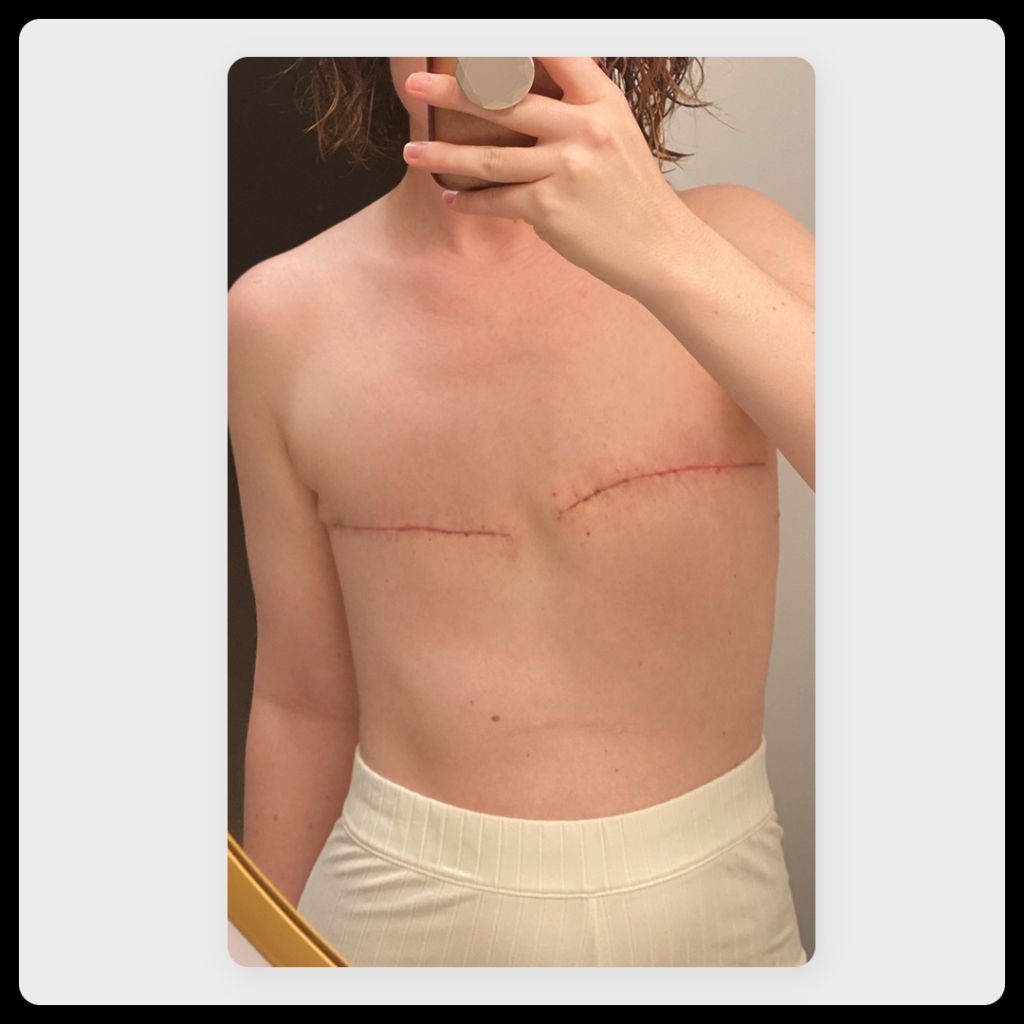
Relearning who I am and my value as a woman
Still, I did go into a deep, dark black hole about my value as a woman. I also realized having more children was not an option, and that hit hard.
But I realized, “If I feel worthless now, then how much value did I put into having breasts, appealing to the male gaze, and having children?”
That was a really hard thing to come up against, but now I feel like it’s the greatest gift of my life. Now I get to decide my worth and my value.
I got to move through and decide who I want to be and what’s important to me, because my whole life I’d gotten it from other people.
You don’t realize where you get your value from until it gets cut off.
Cancer is like coming home from war because you slowly realize that you died in a way. You don’t know who this new person is, and it’s incredibly disorienting. you can’t go back to the status quo. You have to figure out who you are.
I felt like Velma in Scooby Doo when she loses her glasses, bumping into stuff, feeling around in the dark.
The funny thing is that glamor means “illusion.” Of course, there’s nothing wrong with glamor photography. There’s a place for it.
But the photography I do now is raw: no retouching, no hair and makeup. Now I teach that to photographers, and I’m known for that.

Why sharing is important to me
I love to use my platform in the photography world to support going flat. In my experience, doctors don’t usually offer that option or discourage it.
So, sharing my story and my photography is about representation.
My good friend revolutionized the boudoir industry by showing different body types in her photography. She said it’s like exposure therapy: the more people see something, the more they accept it.
What I want other people to know
I want other people to make the decision that’s best for them regardless of what anyone around them says. They need to pick the path, and they’ll feel it in their soul — we all know.
I also want to tell others to learn how to accept help because you’re going to need it. Accepting help is just accepting love, and it’s one of the most beautiful lessons you can learn.
A lot of us are very good at nurturing others, but we have to learn to nurture ourselves.
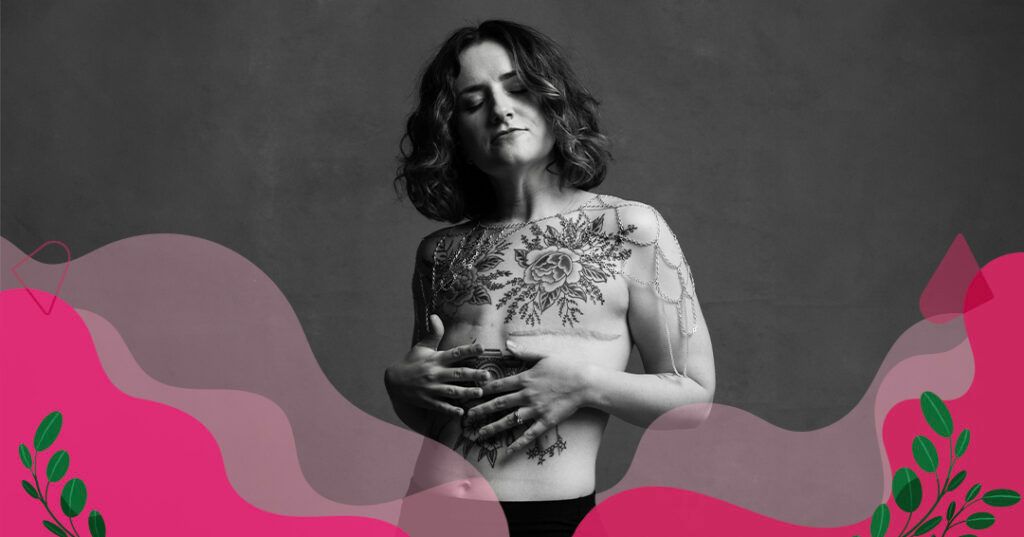
*Although What It Looks Like is an anonymous series, this contributor chose to share her likeness and identity.
Bezzy BC and Young Survival Coalition are partnering to create What It Looks Like, a series showcasing photographs of different breast reconstruction choices on bodies of all shapes, sizes, and colors.
We’re spotlighting the breast reconstruction decisions of people who have had breast cancer so that other people facing mastectomy surgery can see and hear about many different real-life outcomes.
If you’d like to share your reconstruction (or flat closure) images and story, we’d love to hear from you. Just have your photos ready and fill out this submission form.
Images and stories will be anonymously published on BezzyBC.com.
Medically reviewed on October 02, 2024


Like the story? React, bookmark, or share below:
Have thoughts or suggestions about this article? Email us at article-feedback@bezzy.com.
About the author